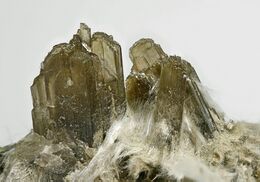Chemistry:Clinozoisite
| Clinozoisite | |
|---|---|
 Clinozoisite | |
| General | |
| Category | Sorosilicates Epidote group |
| Formula (repeating unit) | Ca2Al3(Si2O7)(SiO4)O(OH) |
| Strunz classification | 9.BG.05a |
| Dana classification | 58.2.1a.4 |
| Crystal system | Monoclinic |
| Crystal class | Prismatic (2/m) (same H-M symbol) |
| Space group | P21/m |
| Unit cell | a = 8.879, b = 5.583 c = 10.155 [Å]; β = 115.50°; Z = 2 |
| Identification | |
| Color | Colorless, green, gray, light green, yellow green, pink |
| Crystal habit | Elongated primatic crystals, striated; granular to fibrous |
| Twinning | Lamellar on {100} uncommon |
| Cleavage | Perfect on {001} |
| Fracture | Irregular/uneven |
| Tenacity | Brittle |
| Mohs scale hardness | 6–7 |
| |re|er}} | Vitreous |
| Streak | Grayish white |
| Diaphaneity | Transparent to translucent |
| Specific gravity | 3.3–3.4 |
| Optical properties | Biaxial (+) |
| Refractive index | nα = 1.706 – 1.724 nβ = 1.708 – 1.729 nγ = 1.712 – 1.735 |
| Birefringence | δ = 0.006 – 0.011 |
| 2V angle | 14 to 90° measured |
| References | [1][2][3] |
Clinozoisite is a complex calcium aluminium sorosilicate mineral with formula: Ca2Al3(Si2O7)(SiO4)O(OH). It forms a continuous solid solution series with epidote by substitution of iron(III) in the aluminium (m3 site) and is also called aluminium epidote.[1]
Clinothulite is a manganese bearing variety with a pinkish hue due to substitution of Mn(III) in the aluminium site.[5]
It was originally discovered in 1896 in East Tyrol, Austria, and is so-named because of its resemblance to zoisite and its monoclinic crystal structure.[1]
It occurs in rocks which have undergone low to medium grade regional metamorphism and in contact metamorphism of high calcium sedimentary rocks. It also occurs in saussurite alteration of plagioclase.[2]
Jadeite bearing pyroxene minerals have suggested clinozoisite and paragonite are associated and derived from lawsonite releasing quartz and water via the following reaction:[6]
[math]\ce{ 4CaAl2Si2O8(H2O)2 + NaAlSi2O6 <=> 2Ca2Al3Si3O12(OH) + NaAl3Si3O10(OH)2 + SiO2 + 6H2O }[/math]
References
- ↑ 1.0 1.1 1.2 Clinozoisite on Mindat.org
- ↑ 2.0 2.1 "Clinozoisite in the Handbook of Mineralogy". http://www.handbookofmineralogy.com/pdfs/clinozoisite.pdf.
- ↑ Clinozoisite data on Webmineral
- ↑ Warr, L.N. (2021). "IMA–CNMNC approved mineral symbols". Mineralogical Magazine 85 (3): 291–320. doi:10.1180/mgm.2021.43. Bibcode: 2021MinM...85..291W.
- ↑ Clinothulite on Mindat
- ↑ Deer, William A. (1997). Single-chain Silicates, Volume 2A. Geological Society of London. p. 477.
- Nesse, William D., "Introduction to Mineralogy," (c)2000 Oxford University Press ISBN:0-19-510691-1
 |

